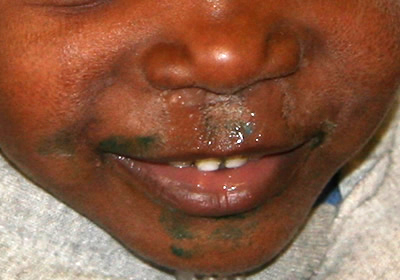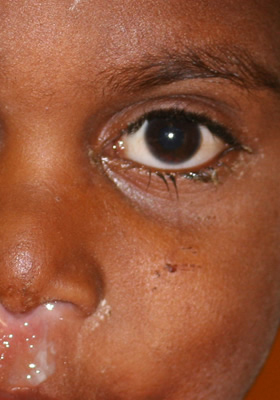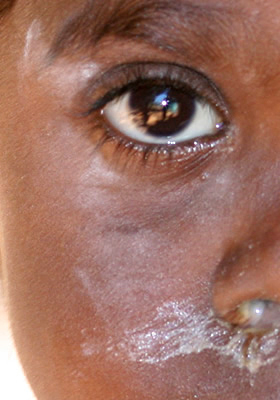Introduction
Facial cleanliness
During trachoma screening, children are assessed for facial cleanliness. The target for clean faces is at least 85% of children examined aged 5–9 years have a clean face.1 Every child’s face must be free of ocular and nasal secretions. This is only achieved by washing faces and wiping noses as often as necessary. (As a measure of good practice, all children should leave a clinic with a clean face irrespective of why they came to the clinic.)
To prevent transmission of trachoma (and other infections) every child should have their face cleaned whenever it necessary.
- A clean face is free of eye and nose secretions.
- An unclean face has eye and/or nose secretions.
- An unclean face in this context is not a runny nose from crying, dirt from playing outside or food on the face.
The definition of ocular and nasal discharge for trachoma grading and assessment is as follows:
Ocular discharge
The presence on the lid margin or lid (including in the corners) of clear or cloudy fluid, or dry matter.2
Nasal discharge
Looking at the child in frontal view, the presence of wet or dry discharge that is outside the nostril. The examiner should not stare up the nostril to find discharge but see the discharge visible outside the nares.3
Note: Young children need help from adults or older children to keep their faces clean. The best practice to reduce trachoma and other infections is summed up in the unified hygiene messaging in the ‘Six Steps to Stop Germs’. Health promotion resources are freely available. Centre for Health Equity: Trachoma
Examples of unclean faces are shown in Figures 1 to 3.

Figure 1: Nasal discharge, crusting.

Figure 2: Nasal discharge with crusting around the eye.

Figure 3: Nasal and ocular discharge with crusting around the eye and face.
1. Communicable Disease Network Australia (2014). Trachoma: CDNA national guidelines for the public health management of trachoma. Canberra: Australian Government Department of Health.
2. CDNA National Guidelines for the Public Health Management of Trachoma [PDF]
3. West SK, Ansah D, Munoz B, Funga N, Mkocha H (2017) The “F” in SAFE: Reliability of assessing clean faces for trachoma control in the field. PLoS Negl Trop Dis 11(11): e0006019. doi: 10.1371/journal.pntd.0006019